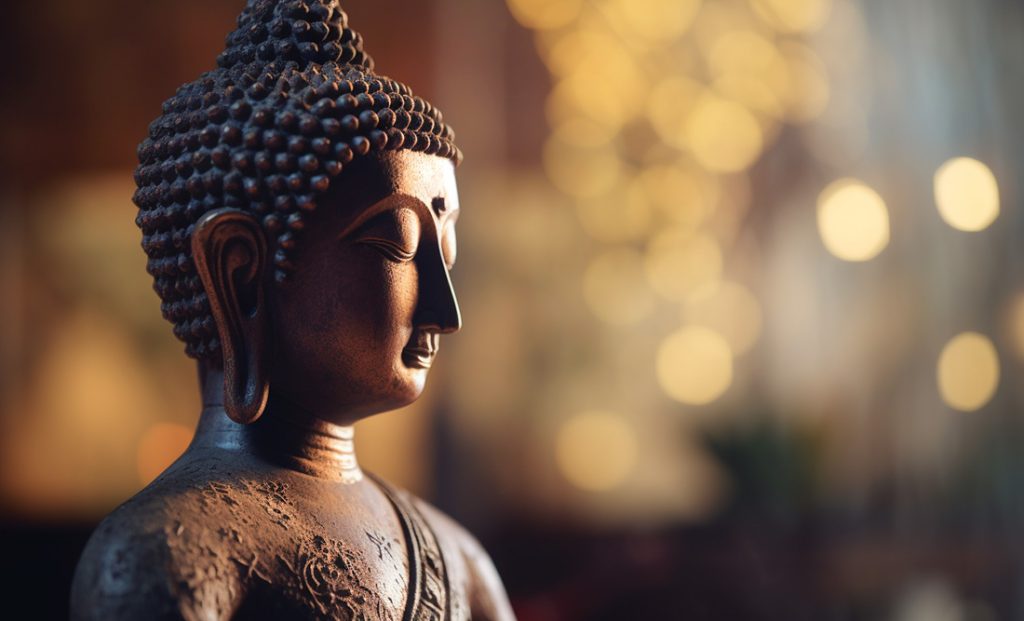Last Updated on June 12, 2025 by Avia
Let’s face it. None of us get out of this life without doing the tango with challenges or problems. After all, without conflict, we could never grow, learn, or develop better ways of living. However, too much stress can make us dull, crazy peeps. At least, that’s what I’ve observed, and that’s why I’ve spent decades practicing different types of meditation.
Hands down, mindfulness practices such as meditation have been a sanity saver for me. I’ll even go so far as to say that meditation has saved my life. In fact, I’m so passionate about this mind, body, and spirit booster that I wanted to share my thoughts and experiences about different types of meditation and how they work. Interested? I hope so! Let’s rock ‘n roll this data-packed download on meditation now!
Table of Contents
- Does Meditation Really Work?
- Reasons You Should Meditate
- Benefits of Meditation
- Types of Meditation
- What is Guided Meditation?
- Which Type of Meditation is Right for Me?
- How Often Should I Meditate?
- What is the Best Time to Meditate?
- What If I Can’t Meditate?
- Frequently Asked Questions About Meditation
- Conclusion

Does Meditation Really Work?
Before I go into the different types of meditation I’m familiar with, let me address the elephant in the room. It’s a question I get often – “Does meditation really work?” or, “Is meditation really worth it?” To this, I respond with a resounding, “Indubitably!” Yes, yes, emphatically yes. Meditation works, and it is worth it!
Meditation has been practiced for thousands of years and has become increasingly popular in recent times due to its numerous benefits. However, you might be skeptical about whether meditation really works or not.
Firstly, it’s important to understand that there is no one-size-fits-all answer when it comes to the effectiveness of meditation. As you can imagine, different types of meditation work differently for different people depending on their unique needs and goals.
That being said, scientific studies have proven that regular practice of various forms of meditation can have a positive impact on both physical and mental health. For example, mindfulness meditation has been found effective in reducing stress levels, while transcendental meditation has been shown to improve brain function.
Moreover, many individuals who incorporate daily meditative practices into their routines report feeling more relaxed, focused, and content in their day-to-day lives. Meditation helps you quiet your mind by focusing your attention, allowing you to be present in the moment, which helps increase self-awareness.
In my world, meditation allows me to be more creative. As a writer, this is huge because, yes, there is such a thing as writer’s block. Oh yeah. It’s real. And when it hits, it can be scary – especially if you write for a living. Over the years, meditation has jostled my doldrums, invigorated my creativity, and helped me out of a lot of creative slumps.
All this to say – there may be varying opinions on whether mediation works or not – but we can’t ignore the evidence-based research that indicates consistent practice can lead to significant improvements in overall well-being. So yeah, I’d say meditation works, and it is definitely worth it!

Reasons You Should Meditate
We all know that meditation is a miracle-worker, so do we really need reasons to meditate? I think maybe an argument supporting meditation is called for because not all of us are doing it, and we should.
One of the main reasons you should meditate is that it can help reduce stress and anxiety. By taking a few minutes each day to focus on your breath and clear your mind, you can lower cortisol levels and promote feelings of calmness and relaxation. Heck, studies have shown lowered cortisol levels even help to lose weight – so that’s a great reason to meditate!
Meditation can also improve overall mental health by increasing self-awareness and promoting a positive mindset. This practice encourages mindfulness, which allows individuals to let go of negative thoughts or emotions that may be holding them back. I can testify to this. When I keep up my meditation routine, I experience remarkable improvements in confidence, self-assurance, and positivity.
In addition to its mental health benefits, meditation has been shown to have physical health benefits as well. It can improve sleep quality, boost the immune system, and even lower blood pressure.
Incorporating meditation into your daily routine can lead to improved well-being in both body and mind. So why not give it a try? Start with just a few minutes each day and see how it can positively change your life.

Benefits of Meditation
Meditation is known to have numerous benefits, both for the mind and body. Rather than yammer on about the benefits of meditation, let’s break it down with this quick rundown countdown to the many perks of meditating:
- Reduce stress levels
- Improves emotional stability
- Enhances self-awareness
- Boosts cognitive function
- Facilitates deep relaxation
- Slows down brain waves
- Helps us manage stress more effectively
- Allows us to process our emotions better
- Manage negative emotions like anxiety or anger
- Helps lift depression and improve mood
- Encourages more vibrant & expansive creativity
- Allows us to identify with our thoughts and emotions better
- Centers and grounds us
- Helps us more easily visualize and achieve our goals
- Encourages confidence and self-esteem
- Helps with problem-solving & decision making
- Fosters deeper connection with ourselves and other people
- Provides more clarity and focus
- Positively changes the structure of our brains
- Improves memory retention
- Reduces blood pressure, and respiratory function, & improves a slew of physical conditions
- Unites us with nature and our environment
- Gets us grounded and stabilized
- Enhances spirituality and our connection with the divine
- It can make us feel and even look younger
- Improves performance at school, work, and home
Let’s see. Did I forget anything? Of course I did – the list of benefits of meditation are virtually endless, and there are a lot more top marks I might have missed. Oh, like…
- It’s 100% free
- It’s easy to do (it really is – even if you think it isn’t)
- You can do it anywhere, anytime
- 100% all-natural way to improve your mind, body, and spirit.
Types of Meditation
Now, let’s get to the meat of this meditation piece! The good news is you can reap all the aforementioned rewards of meditation. The bad news is – well, there isn’t any. Unless you think meditation is hard or inaccessible (it isn’t).
But even if you’ve tried and so-called failed to meditate – there’s more good news. There are different types of meditation you can practice, each with its own unique approach and benefits. If one type of meditation doesn’t work – try a different one!
For instance, many people complain that sitting stock-still like a yogi simply doesn’t work. That’s cool and understandable. That’s also when you should ditch that style of meditation and try a different type of meditation, such as walking, gardening, or painting.
Wait, what? Am I saying you can meditate while doing stuff? Yes!!! Practicing hyper-mindfulness while doing the dishes can even be a meditation.
I’ll give you an example. Washing dishes has become one of my favorite types of meditation. I synchronize my breath with each stroke of the sponge. Then I deeply connect with the water. I let my mind flow, and I usually wind up conversing with my grandma, who is no longer with us in the physical sense (she and I always did dishes together after a big family meal).
Anyhoo – my point is there are different types of meditation – even ones that aren’t on this list. You can even create your own type of meditation (like the washing-dishes meditation I just described) to fit your unique needs.
Oh, and remember – there’s no single “right” way to meditate. Each individual may find success in different approaches depending upon their needs, but knowing these different styles will allow you to experiment until finding what works best for you!
It doesn’t matter if you’re a beginner at meditation or a veteran – trying different types of meditation is always a good idea to expand, broaden, and improve yourself and your life. So, let’s get kickin’ and explore some of these different types of meditation together!

Mindfulness Meditation
Mindfulness meditation is a type of meditation that focuses on being present in the moment and aware of your thoughts, feelings, and sensations without judgment. It involves paying attention to your breath or body sensations while allowing thoughts to come and go naturally.
During mindfulness meditation, you aim to observe your emotions without getting caught up in them. You become more aware of how your mind works and gain insight into the root causes of stress, anxiety, or depression.
One benefit of mindfulness meditation is its ability to reduce emotional reactivity by increasing self-awareness. This can lead to better decision-making abilities and lower levels of stress overall.
Additionally, studies have shown that practicing mindfulness for as little as 10 minutes a day can improve brain function related to memory, focus, and cognitive flexibility.
If you’re looking for an accessible way to start meditating or want to enhance your existing practice with something new, mindfulness meditation might be worth considering.
Transcendental Meditation
Transcendental Meditation (TM) is a type of meditation that involves the use of a mantra, which is a word or phrase that you repeat silently in your mind. This technique was developed by Maharishi Mahesh Yogi and became popular in the 1960s. I was first introduced to TM through the David Lynch Foundation, and it revolutionized my life.
The practice of TM involves sitting comfortably with your eyes closed and repeating your mantra for about 20 minutes at a time. The goal is to achieve deep relaxation and reduce stress levels in both the mind and body.
Unlike other forms of meditation, where you may focus on your breath or bodily sensations, TM aims to bring you to a state of transcendence beyond thought or action. This means letting go of any distractions or thoughts that come up during the practice and allowing yourself to fully relax into the present moment.
Research has shown that practicing TM regularly can have numerous benefits, such as reducing anxiety, improving sleep quality, increasing brain function, and boosting overall well-being.
While some people may find it difficult to choose their own mantra, trained instructors usually provide personalized mantras based on individual characteristics and needs. Transcendental Meditation can be an effective way for individuals looking to reduce stress levels while enhancing their well-being through regular meditation practice.

Focused Meditation
Focused meditation is a type of meditation that aims to improve concentration and focus. This type of meditation involves focusing your attention on a single object or thought, such as your breath, an image, or a sound. My preference is to focus on a flickering candle until I get into that coveted, groovy, trance-like state.
To start focused meditation, find a quiet place where you won’t be disturbed. Sit down in a comfortable position and close your eyes. Focus on the sensation of your breath moving in and out of your body. Then choose a symbol, mental image, object, or thought to focus upon. This could be an intention or a vision of something that is uplifting or calming.
As thoughts come into your mind, acknowledge them but then let them go without dwelling on them. Keep bringing yourself back to the sensation of breathing.
Over time, practicing this type of meditation can help improve cognitive function by strengthening neural connections related to attention and focus. It may also help reduce stress levels by redirecting mental energy away from negative thoughts.
Focused meditation can benefit individuals who struggle with procrastination or have difficulty concentrating for prolonged periods. Overall it’s an excellent way to build up mental resilience while improving productivity over time through consistent practice.
Spiritual Meditation
One of my personal favorites among the different types of meditation, spiritual meditation focuses on connecting with a higher power or inner self through visualization or prayer. It can be beneficial for those seeking spiritual growth or looking for greater meaning in their lives.
Spiritual meditation is a practice that involves connecting with your inner self and the divine. It takes you beyond the physical realm and into the spiritual realm of existence. This type of meditation can help you to find meaning in life, develop a deeper sense of purpose, and experience a greater sense of peace.
During spiritual meditation, you focus on your breath while visualizing yourself surrounded by light or new energy. The idea is to connect with something bigger than yourself, whether it be God, nature, or any other higher power that resonates with you.
This practice has been used for centuries as a way to deepen one’s faith and strengthen their connection with their chosen deity. Many people who practice spiritual meditation report feeling more grounded, centered, and peaceful after each session.
I use spiritual meditation when I want to connect with peeps who are no longer with us in the physical realm. I’ve had smashing good luck connecting and communicating with my ancestors and family members who have passed on. This has given me phenomenal insights, and I’ve even gotten solid advice from loved ones on the other side of the veil through spiritual meditation.
Spiritual meditation can also help you gain clarity about what you want in life while helping you cultivate gratitude for received blessings. By tuning into our intuition through this form of meditation, we are able to make better decisions aligned with our values.

Mantra Meditation
Mantra meditation is a type of meditation that involves the repetition of a word, phrase or sound. The mantra acts as a focal point for the mind and helps to bring about inner peace and calmness. Mantras can be simple phrases such as “Om” or “I am at peace,” or they can be more complex phrases specific to one’s spiritual practice.
The use of mantras in meditation has been practiced for centuries, particularly in Eastern cultures. It is believed that the vibration created by repeating a mantra can help purify the mind and body, leading to greater awareness and spiritual growth.
To begin practicing mantra meditation, choose a word or phrase that resonates with you personally. Sit comfortably in a quiet space with your eyes closed, take deep breaths and slowly repeat your chosen mantra aloud or silently to yourself.
As you continue to focus on your chosen mantra, allow any distracting thoughts or feelings to simply pass through without judgment. With regular practice, many practitioners find that this meditative technique leads to increased mindfulness and decreased stress levels.
Mantra meditation can be an excellent option for those who have difficulty quieting their minds during traditional forms of silent meditation practices.
Movement Meditation
Remember me talking about how doing activities in a mindful way can be an effective meditation? Well, this is known as “movement meditation.” It’s a type of meditation that involves movement and physical activity. Unlike traditional meditative practices, it encourages individuals to focus on their body movements rather than stillness.
The practice involves slow, intentional movements such as walking (I recommend walking a labyrinth for a phenom meditation), dancing, or even yoga poses. Another great mindful movement practice perfect for movement meditation is Tai Chi, which I’ve practiced for decades with spectacular results.
The goal of movement meditation is to improve one’s awareness and connection with the body by promoting bodily intelligence. It allows you to become more present in the moment while moving in a way that feels good for your body. The beauty is anything can become a movement meditation (even doing dishes, lol) – as long as you are super-conscious of your mind, body, movement, breath, etc.
Some benefits of movement meditation include reducing stress levels, improving mental clarity and concentration, and increasing self-awareness. It can also be an excellent way for those who struggle with sitting still during meditation to engage in mindfulness practices.
Movement meditation may not suit everyone’s preference due to its active nature, but if you enjoy being physically engaged while meditating or have trouble focusing during seated meditation sessions, this approach could be the perfect solution.
In fact, mindful movement meditation is a fabulous alternative to traditional “sit still, be quiet” sessions because it tends to settle overactive minds – which is often a barrier to entry for many beginner meditators.

Mindfulness Meditation
The practice of mindfulness involves being fully present and aware of one’s thoughts, feelings, and surroundings without judgment. It’s that nifty suspension of objectifying or identifying that frees the mind to enter wide open spaces – resulting in a glorious trip – at least for me, it’s a great high without using drugs.
During mindfulness meditation, you’re encouraged to focus your attention on the present moment by paying attention to your breath or bodily sensations. By doing so, you can learn to observe your thoughts and emotions from a distance without getting caught up in them.
The goal of mindfulness meditation is not to eliminate thoughts or emotions but rather to cultivate an attitude of curiosity and acceptance toward them. This allows you to develop greater emotional regulation skills and reduce stress levels over time.
Research studies have shown that regular mindfulness practice can lead to improved mental health outcomes such as reduced anxiety symptoms, lower depression rates, increased well-being, and better cognitive functioning.
Practicing mindfulness can help you become more self-aware and connected with yourself while also developing compassion for others around you.
Yoga Meditation
Yoga meditation is a type of meditation that combines physical movements with mindfulness and breath control to promote relaxation, reduce stress, and increase overall well-being. The practice originated in ancient India as part of the larger system of yoga, which aims to unite the mind, body, and spirit.
Yoga meditation involves practicing a series of postures or asanas while focusing on your breath and clearing your mind. By combining movement and mindfulness, yoga meditation can help you achieve a deeper level of relaxation than other forms of meditation.
One benefit of yoga meditation is its ability to improve flexibility and balance while also reducing stress levels. It has been shown to be effective in treating symptoms related to anxiety disorders, depression, and chronic pain conditions such as fibromyalgia or arthritis.
Another advantage is that it doesn’t require any special equipment or expensive classes; all you need are comfortable clothes, a mat, or a towel for cushioning purposes if necessary. You can even YouTube yoga meditation techniques online for free. I love Yoga With Bird on YouTube for regular yoga, but I noticed she also has a few guided meditations on her channel.
Yoga meditation offers an approachable way for anyone who wants some peace from daily life stresses without necessarily having advanced meditative skills like those required by more traditional practices.
Zen Meditation
Zen meditation, also known as Zazen, is a type of meditation that originated in China and later spread to Japan. The practice of Zen involves sitting in a specific posture and focusing on your breath while letting go of any distracting thoughts or emotions that arise.
The goal of Zen meditation is to achieve enlightenment or deep insight into the nature of reality. It is believed that this can be accomplished by quieting the mind and allowing it to become still.
One unique aspect of Zen meditation is its emphasis on non-dualistic thinking, which means seeing things as they truly are without attaching labels or judgments. This allows practitioners to experience a sense of interconnectedness with all things.
Zen meditation can be challenging for beginners due to its strict focus on posture and breathing techniques. However, with practice, many people find it to be a deeply rewarding form of meditation that helps them develop greater clarity, awareness, and inner peace.
If you’re looking for a meditative practice that emphasizes mindfulness and non-judgmental awareness while also helping you tap into deeper insights about yourself and the world around you, then Zen meditation may be worth exploring further.

Chakra Meditation
Chakra meditation is a type of meditation that focuses on the seven energy centers in the body known as chakras. These centers are believed to be located along the spine, starting from the base and ending at the crown of the head. Each chakra corresponds to specific physical and emotional aspects of our being.
The goal of chakra meditation is to balance these energy centers, allowing for a more harmonious flow throughout the body. This can lead to a greater sense of well-being and improved physical health.
During chakra meditation, practitioners may use visualizations or mantras associated with each chakra while focusing on their breath. The practice may also involve using gemstones or crystals placed on corresponding areas of the body.
Chakra meditation has been shown to have numerous benefits, including stress reduction, increased mindfulness, and improved overall health. It can also help with emotional healing by addressing imbalances in specific areas related to personal growth and development.
While it may seem daunting at first, incorporating regular chakra meditations into your routine can bring about profound changes both physically and emotionally.
Qigong Meditation
Qigong (pronounced chee · gung) meditation is a type of traditional Chinese meditation that focuses on the flow of energy within the body. It involves slow, rhythmic movements and deep breathing exercises to promote relaxation and balance in both the mind and body.
The practice of Qigong has been found to have numerous benefits for overall health and harmony. It can help reduce stress, improve circulation, boost the immune system, increase flexibility, and enhance mental clarity.
One unique aspect of Qigong meditation is its emphasis on cultivating Qi (or Chi) or life force energy. Practitioners believe that by focusing on this energy, they can achieve greater physical strength, emotional stability, and spiritual awareness.
Qigong techniques include standing postures and gentle movements similar to Tai Chi Chuan forms combined with breath control. These practices are easily adaptable for people with limited mobility or who prefer a seated posture.
Overall, Qigong Meditation can be an effective tool to promote physical well-being as well as inner peace through focused movement patterns while strengthening one’s connection between internal self-awareness and the external environment

Vipassana Meditation
Vipassana meditation is an ancient technique that originated in India over 2,500 years ago. It involves a deep focus on the breath and body sensations to develop self-awareness and mindfulness.
In Vipassana meditation, practitioners sit in silence for extended periods of time, usually for ten days or more. They observe their thoughts and physical sensations without judgment or reaction, allowing them to become more aware of their subconscious patterns.
The goal of Vipassana meditation is to achieve liberation from suffering by developing insight into the true nature of reality. This practice teaches individuals how to accept life as it comes and respond with compassion instead of reacting impulsively.
Vipassana meditation has been shown to improve mental clarity, emotional stability, and overall well-being. It can also reduce stress levels and increase feelings of happiness and contentment.
However, this type of meditation requires discipline, patience, and dedication. It’s important to seek guidance from experienced teachers who can help you navigate your way through this challenging yet rewarding practice.
What is Guided Meditation?
Guided meditation is a type of meditation that involves listening to an instructor or guide who leads you through the process. This type of meditation can be particularly helpful for beginners or those who struggle with focusing during their practice.
During guided meditation, the guide might use visualization techniques to help you relax and visualize peaceful scenes in your mind. The guide may also provide affirmations or positive statements to repeat silently to yourself during the practice.
Guided meditation can take many forms, including audio recordings, videos, or live classes. Some people prefer a more personalized approach and opt for one-on-one guided sessions with a teacher.
One benefit of guided meditation is that it takes some pressure off the individual meditator by providing structure and guidance throughout the practice. Additionally, following along with an expert can help deepen your understanding of different types of meditations and how they work.
Guided meditation can be a great tool for anyone looking to incorporate more mindfulness into their life but isn’t sure where to start.

Which Type of Meditation is Right for Me?
Choosing the right type of meditation can be a daunting task, especially for beginners. With so many different types of meditations available, it’s easy to feel overwhelmed and unsure which one is best suited for you.
One important thing to consider when choosing a type of meditation is your personal goals and needs. Here are a few suggestions that might help you pick the right meditation for you:
- If you’re looking to reduce stress and anxiety, mindfulness or mantra meditation may be best for you.
- On the other hand, if you’re seeking spiritual growth and enlightenment, spiritual or chakra meditation may be more beneficial.
- If you have limited time but still want to meditate regularly, focused or movement meditation might work better as they require less time commitment.
- Alternatively, if you’re in for a penny, in for a pound, and can commit to some super-intense meditation (with equally super benefits), then different types of meditation such as transcendental or Vipassana, might be up your alley.
- Also, consider your personal preferences, such as whether you prefer an active or passive approach to meditating (mindful vs. movement meditation).
Ultimately finding the right type of mediation is about experimentation and trial and error until something resonates with both your mind and body. Don’t hesitate to try out different types of meditation until one resonates with you!
How Often Should I Meditate?
One of the most common questions people have about meditation is how often they should practice it. The answer to this question depends on a few factors, including your goals for meditation and how much time you can realistically commit to the practice.
If you’re new to meditation, I recommended that you start with just a few minutes per day and gradually work your way up to longer sessions. This will help you build consistency in your practice without overwhelming yourself.
For those who are looking to use meditation as a tool for stress relief or anxiety management, practicing daily is ideal. Even just 10-15 minutes of meditation each day can have significant benefits for both mental and physical health.
However, if you’re using meditation for spiritual purposes or deeper introspection, longer and more frequent sessions may be in order. It’s important to listen to your body and mind when deciding how often and how long to meditate.
Ultimately, there’s no one-size-fits-all answer when it comes to how often you should meditate. Experiment with different frequencies and durations until you find what works best for you personally.

What is the Best Time to Meditate?
The best time to meditate is whenever it works for you. Some people prefer to meditate in the morning before starting their day. This can help them feel more centered and focused throughout the day. Others prefer to meditate at night as a way to wind down and relax before bed.
If you’re new to meditation, it might take some experimentation to figure out what works best for you. You might want to try meditating at different times of the day and see how it affects your mood and energy levels.
One thing to keep in mind is that consistency is key when it comes to meditation practice. It’s better to meditate regularly, even if only for a few minutes each day, than sporadically for longer periods of time.
Another factor that can influence when you choose to meditate is your schedule. If you have a busy job or family life, finding time early in the morning or later at night might be the only option.
Ultimately, there’s no one “right” answer when it comes to the best time of day for meditation – it all depends on what feels most comfortable and sustainable for you.
What If I Can’t Meditate?
At this point, it should be clear I’m a big advocate of meditation for living our best lives. Because I’m a convert is probably why I’m pretty adamant that everybody can meditate – even if they say or feel like they can’t. I’ll admit. Meditation is not always easy, and it may take some time to get the hang of it. So, if you are struggling with meditation, don’t worry! There are a few things you can do.
Firstly, try to find a comfortable and quiet place where you won’t be disturbed. Distractions like noise or movement can make it hard to focus on your breath or mantra.
Secondly, try different types of meditation until you find one that works for you (I’ve given you a great variety to choose from here!). Everyone’s mind works differently, so what works for someone else might not work for you.
Thirdly, focus on your breathing – inhale deeply through your nose and exhale slowly through your mouth. This will help calm your body down and clear your mind.
Don’t judge yourself if thoughts come up during meditation. It’s normal for the mind to wander; simply acknowledge them and bring yourself back to focusing on the present moment.
Remember that meditation is about progress over perfection – even a few minutes of practice each day can have significant benefits over time.

Frequently Asked Questions About Meditation
No, you don’t need to follow any specific religion or have any particular beliefs to practice meditation. It is a secular practice that can be done by anyone.
There isn’t a set time that works for everyone. Some people find just a few minutes of meditation helpful while others prefer longer sessions. It’s important to find what works best for you and your schedule.
Yes, you can meditate in any position that feels comfortable for you – sitting, standing, walking or even lying down. However, some people find it easier to stay alert and focused when they are seated upright.
Yes! Studies have shown that even very young children can benefit from mindfulness practices as they help them develop better focus and emotional regulation skills.
This is completely normal – our minds are wired to constantly think and wander. When this happens during meditation, simply acknowledge the thought without getting caught up in it and gently redirect your attention back to your breath or chosen point of focus.
Remember, there is no right or wrong way to meditate – what matters most is finding a practice that resonates with you personally and sticking with it consistently over time. So whether you meditate with crystals, do yoga meditations, or do visual meditation – it’s all good!
Conclusion
Meditation is a powerful tool that can help improve your physical, mental, and emotional health. It has numerous benefits and can be practiced in many different ways to suit your personal preferences and needs.
By trying out the various types of meditation mentioned in this article, you may discover which one works best for you. Remember that there is no right or wrong way to meditate – it’s all about finding what feels most natural and effective for you.
Make meditation a regular part of your routine by setting aside time every day or week to practice. Start with just a few minutes per session and gradually increase the duration as you become more comfortable.
If, at first, you find it challenging to quiet your mind during meditation sessions, don’t give up! With patience and practice, anyone can learn how to meditate effectively.
I hope this article has helped shed some light on the different types of meditation available and how they work. May it inspire you to start or continue on your journey toward inner peace and well-being through the ancient art of meditation! As always, thanks for reading!
Mighty brightly,

© Copyrighted. All Rights Reserved.












